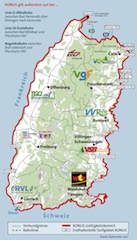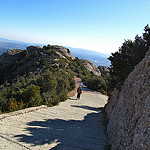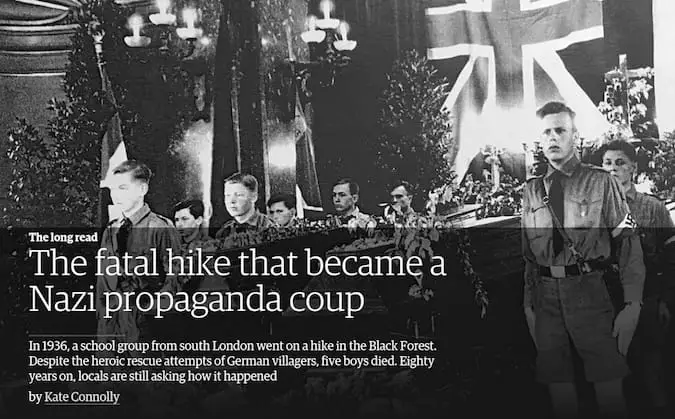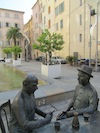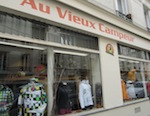It is a truth universally acknowledged (at least in my house it is) that every holiday break of more than three days must be spiced up with a bit of variety.
More specifically, such longer holiday breaks should include two things: first, one day trip where you do something totally different from what you are doing the rest of your stay. F or example go out for a country walk when you are on a city break (we shall deal with that next week).
Secondly, a break-inside-a-break where you go somewhere else within your region, a place which is as different as is possible for an easy-to-reach day trip destination.
Which is why, today, we are heading off from Como to Lugano.

Lugano and Como have quite a lot in common – not least their waterfront location on the shores of a lake that was named after them (or was it the other way round?). But there are also important differences.
Already in the Middle Ages, Como and Lugano often found themselves on different sides of local wars, and even today, the two towns are located on different sides of a national border. The Italian city of Como is practically a border town, only 4 km away from Switzerland, while Lugano, about 20 km further to the north, is the regional capital of the Ticino and the largest city in the Italian-speaking part of the Swiss Confederation.

You should never forget your first impression of a place. It is likely that you will want to qualify much of that later on when you have gained a more in-depth experience, but these first impressions often contain sharp little truths that time and learning will only blunt.
And here is my first impression of Lugano: it is Italian but not quite, like something out of a Chinese-theme-park Italy where the operators have diligently followed the recipe but left out one vital ingredient.
After some thought, I identified the missing ingredient as anarchy, or rather: that specific Italian brand of anarchy that is naturally generated whenever more than two Italians congregate in the same physical space.

Fully Italian or not, Lugano is without a doubt quite lovely, and any exploration of the town should begin where it is at its most beautiful: down by the lake, at the foot of the old town.

This is where Lugano really shines …

… and where the scenery is at its most flamboyant and dramatic. (LugaYes!)

Considering Lugano’s relatively high latitude, it is amazing how much exotic flora you will encounter on your walk. Lugano lies roughly on the same parallel as Clermont-Ferrand in central France, a place we have visited before, and I certainly do not recall having seen any palm trees then.
You have to leave it to Lugano: if you are looking for somewhere to travel to in late winter where you find yourself surrounded by subtropical plants while you hands are freezing stiff, this is definitely the place to go.

After our lakeside stroll, we had planned to take a longer walk on one of the two mountains that overlook Lugano. On both mountains, a funicular cabin service can take you to a network of short and longer routes on which to explore the landscape.
When we got to the street level station of Monte Bre, however, which is advertised as “Switzerland’s sunniest mountain”, the funicular was closed, due to seasonal maintenance works.
So we went to the other side of town to the funicular station of Monte San Salvatore – fortunately, there was a bus stop right there with a ticket dispenser that accepted our credit card – only to find out that it was only open on weekends. (LugaNo!)

Having been deprived of our little mountain adventure, we decided to walk instead from the quarter in which he found ourselves, the only slightly misnamed Paradiso …

… back to the town centre.

This is a pleasant and scenic lakeside route, but what really makes the walk interesting is the Lugano Sculpture Park – and the story of the Villa Tanzina which once stood in its place.
The Villa, formerly one of Lugano’s grandest mansions, was purchased in 1840 by an Italian adventurer and revolutionary named Abbondio Chialiva who had fled his home country following a failed Republican uprising.
After he had made a fortune having discovered a gold mine in Peru and returned to Europe a fabulously wealthy man, he bought an old aristocratic palace right on the Italian border – the Villa Tanzina – to turn it into an asylum for political refugees from his home country.
The Villa was demolished in 1908 (to make way for a public road and the quai), and only the George Washington Rotunda has survived, built by Chialiva to honour the “patron saint” of all European anti-monarchists.

The Sculpture Park was inaugurated in the late 1970s, when Lugano’s city administration decided to turn the art works of a modern art festival into the core of a permanent open-air exhibition.
Over the years, the Park’s collection was gradually enlarged with other works that had been on public display elsewhere in Lugano.

We only came to the Sculpture Park by chance, but it turned out to be the highlight of our visit, mainly because the scenic background of Lake Lugano creates such delightful effects. (LugaYes!)

Finally, a few practical suggestions. If you are coming from Como by train, do not book your ticket on a website. You will be charged approx. € 20 p.p. one-way, while we paid only € 19.60 for a day return at the counter in Como station. This is still more expensive than what you would pay on an Italian train (the line is operated by the Swiss Federal Railways) but remains just on the right side of reasonable.
Which is more than can be said for most other things in Switzerland. Everything is expensive there, but whereas it is relatively easy to avoid buying clothes and fresh produce, restaurants are a different matter.
So here is another LugaNo: do not eat out there. We passed a roadside eatery, a nice-ish but by no means luxurious establishment, and had a glimpse at the menu where starters were listed at around € 30 while main courses started in the mid-40s.
I once read that one out of six Swiss residents is a millionaire. At these prices, they need to be.
For us, it was the McDo Cafe, where we paid 10 bucks for two coffees and Mrs. Easy Hiker’s donut.
Having said that, it was the most stylish McDonald’s we had ever seen, an Art Nouveau steel-and-glass structure with a lakeside view thrown in. (LugaYes!)

So you see: when you come to Lugano, be ready for delightful and frustrating experiences: many LugaYeses but also many LugaNos. Much of this is the result of throwing together two things that do not mix: oil and water, Switzerland and Italy.
Some things blend, and some things will remain for ever alien to one another. It can still, however, be fun to look at them.


